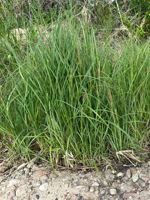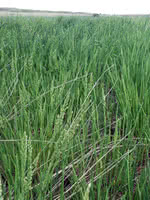Mon-Fri 9am - 5pm Mountain time
Slough Grass vs Wheat Sedge
Carex atherodes
Beckmannia syzigachne
CUSTOM GROW
CUSTOM GROW
Wheat Sedge is a native perennial sedge commonly found in wetlands, ditches, and along shorelines. It thrives in saturated soils, spreading by rhizomes to form large colonies that stabilize both soils and shorelines. This makes it valuable for wetland and riparian plantings.
Its distinctive, wheat-like seed spikes add seasonal character while providing food for waterfowl, and its dense clumps supply cover and nesting habitat for birds and small animals. Together, these traits make Wheat Sedge an important species for enhancing biodiversity and supporting healthy wetland ecosystems.
Slough Grass is a hardy grass that will happily grow in any wet soil. It is usually found near water and is common haymaking material or forage.
Slough Grass is also useful for erosion control and land reclamation.

